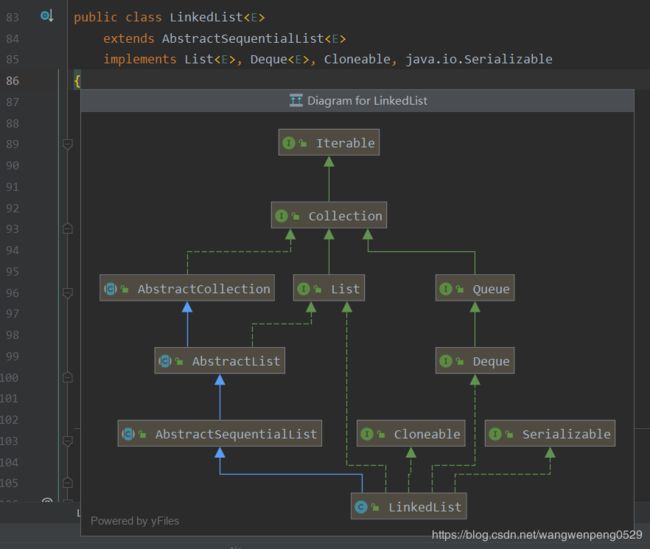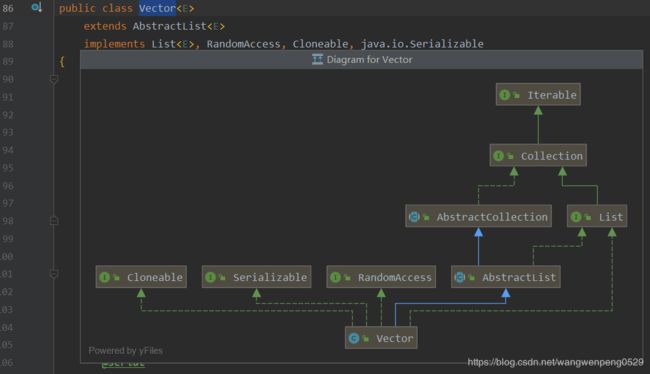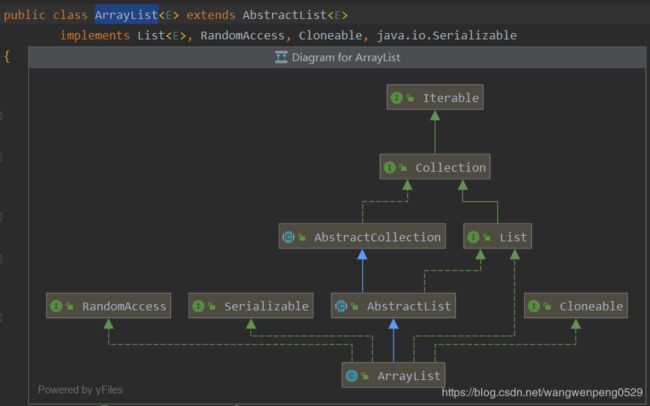JavaCore-彻底搞懂集合-collection接口集合体系详解二-List接口-ArrayList-LinkedList-Vector-ArrayList的实现原理
List接口及实现
- 概述
- ArrayList源码分析
- jdk7
- 初始化
- 扩容
- jdk8
- 初始化
- 扩容
- Arraylist 最大值
- Arraylist小结
- LinkedList源码分析
- jdk8
- LinkedList小结
- Vector
- ArrayList与Vector
- Arraylist与LinkedList
- 总结
参考这篇文章,写的很好
Java集合容器面试题(2020最新版)
概述
List存储有序的、可重复的数据。 存储元素和取出元素的顺序是一致的,有索引,包含了一些带索引的方法,允许存储重复的元素
List接口的实现类
ArrayList:作为List接口的主要实现类;线程不安全的,效率高;底层使用Object[] elementData存储
LinkedList:对于频繁的插入、删除操作,使用此类效率比ArrayList高;底层使用双向链表存储
Vector:作为List接口的古老实现类;线程安全的,效率低;底层使用Object[] elementData存储
ArrayList
优点: 底层数据结构是数组,查询快,增删慢。
缺点: 线程不安全,效率高
Vector
优点: 底层数据结构是数组,查询快,增删慢。
缺点: 线程安全,效率低
LinkedList
优点: 底层数据结构是链表,查询慢,增删快。
缺点: 线程不安全,效率高
ArrayList源码分析
jdk7
初始化
从网上看7中对arraylist的初始化的长度是10,但是我这边1.70U80版本的源码中没有初始化长度是10,不知道之前的哪个版本是这么写的,那就从其他博客里看一下,弄过来写上。
从这里可以看到,空参的构造调用了带数组长度参数都的构造器,指定了长度是10,底层new Object长度是10的数组,其实arraylist的底层还是数组。
/**
* Constructs an empty list with the specified initial capacity.
*
* @param initialCapacity the initial capacity of the list
* @throws IllegalArgumentException if the specified initial capacity
* is negative
*/
public ArrayList(int initialCapacity) {
super();
if (initialCapacity < 0)
throw new IllegalArgumentException("Illegal Capacity: "+
initialCapacity);
this.elementData = new Object[initialCapacity];
}
/**
* Constructs an empty list with an initial capacity of ten.
* 创建一个长度是10的object类型的数组
*/
public ArrayList() {
this(10);
}
/**
* Constructs a list containing the elements of the specified
* collection, in the order they are returned by the collection's
* iterator.
*
* @param c the collection whose elements are to be placed into this list
* @throws NullPointerException if the specified collection is null
*/
public ArrayList(Collection c) {
elementData = c.toArray();
size = elementData.length;
// c.toArray might (incorrectly) not return Object[] (see 6260652)
if (elementData.getClass() != Object[].class)
elementData = Arrays.copyOf(elementData, size, Object[].class);
}
扩容
往数组里去添加元素的时候执行add方法,先看arraylist的大小够不够,不够的情况下进行扩容。
/**
* Appends the specified element to the end of this list.
*
* @param e element to be appended to this list
* @return true (as specified by {@link Collection#add})
*/
public boolean add(E e) {
ensureCapacityInternal(size + 1); // Increments modCount!!
elementData[size++] = e;
return true;
}
可以看到先进行扩容的方法之后再执行的把添加的元素放到第size++上,后加加这种操作,先使用size的值,比如第一次添加的时候size是0,添加的时候先使用size,第0位置成添加进去的E,准确的理解是E地址值。之后size加一操作,数组的大小就成了1,这样的写法真是太方便了。
接下来看这个方法ensureCapacityInternal,里面又调用了grow
private void ensureCapacityInternal(int minCapacity) {
modCount++;
// overflow-conscious code
if (minCapacity - elementData.length > 0)
grow(minCapacity);
}
grow才是真正的扩容方法
/**
* Increases the capacity to ensure that it can hold at least the
* number of elements specified by the minimum capacity argument.
*
* @param minCapacity the desired minimum capacity
*/
private void grow(int minCapacity) {
// overflow-conscious code
int oldCapacity = elementData.length;
int newCapacity = oldCapacity + (oldCapacity >> 1);
if (newCapacity - minCapacity < 0)
newCapacity = minCapacity;
if (newCapacity - MAX_ARRAY_SIZE > 0)
newCapacity = hugeCapacity(minCapacity);
// minCapacity is usually close to size, so this is a win:
elementData = Arrays.copyOf(elementData, newCapacity);
}
int newCapacity = oldCapacity + (oldCapacity >> 1);
可以看到这里的右移操作,将原来的长度扩容为原来的1.5倍,然后将原来的数组复制一遍放到现在的数组上。其中还加了一步判断,免得右移一位之后超过临界值。
jdk8
初始化
jdk8中的初始化无参的构造中没有指定具体的长度,只是声明了这个数组,没有指定长度;在有参的构造这里,参数是长度,长度大于0的时候才会指定数组的长度,长度是0的时候,还是没有指定长度,只是声明这么一个数组。
jdk7中的ArrayList的对象的创建类似于单例的饿汉式,而jdk8中的ArrayList的对象的创建类似于单例的懒汉式,延迟了数组的创建,节省内存。
/**
* Constructs an empty list with the specified initial capacity.
*
* @param initialCapacity the initial capacity of the list
* @throws IllegalArgumentException if the specified initial capacity
* is negative
*/
public ArrayList(int initialCapacity) {
if (initialCapacity > 0) {
this.elementData = new Object[initialCapacity];
} else if (initialCapacity == 0) {
this.elementData = EMPTY_ELEMENTDATA;
} else {
throw new IllegalArgumentException("Illegal Capacity: "+
initialCapacity);
}
}
/**
* Constructs an empty list with an initial capacity of ten.
*/
public ArrayList() {
this.elementData = DEFAULTCAPACITY_EMPTY_ELEMENTDATA;
}
/**
* Constructs a list containing the elements of the specified
* collection, in the order they are returned by the collection's
* iterator.
*
* @param c the collection whose elements are to be placed into this list
* @throws NullPointerException if the specified collection is null
*/
public ArrayList(Collection c) {
elementData = c.toArray();
if ((size = elementData.length) != 0) {
// c.toArray might (incorrectly) not return Object[] (see 6260652)
if (elementData.getClass() != Object[].class)
elementData = Arrays.copyOf(elementData, size, Object[].class);
} else {
// replace with empty array.
this.elementData = EMPTY_ELEMENTDATA;
}
}
扩容
/**
* Appends the specified element to the end of this list.
*
* @param e element to be appended to this list
* @return true (as specified by {@link Collection#add})
*/
public boolean add(E e) {
ensureCapacityInternal(size + 1); // Increments modCount!!
elementData[size++] = e;
return true;
}
private void ensureCapacityInternal(int minCapacity) {
ensureExplicitCapacity(calculateCapacity(elementData, minCapacity));
}
private static int calculateCapacity(Object[] elementData, int minCapacity) {
if (elementData == DEFAULTCAPACITY_EMPTY_ELEMENTDATA) {
return Math.max(DEFAULT_CAPACITY, minCapacity);
}
return minCapacity;
}
Math.max(DEFAULT_CAPACITY, minCapacity);这里默认的长度就出来了,添加一个元素之后的长度和这个default长度进行比较,取较大的一个。添加一个后,数组的长度就初始化成10了。
private void ensureExplicitCapacity(int minCapacity) {
modCount++;
// overflow-conscious code
if (minCapacity - elementData.length > 0)
grow(minCapacity);
}
/**
* Increases the capacity to ensure that it can hold at least the
* number of elements specified by the minimum capacity argument.
*
* @param minCapacity the desired minimum capacity
*/
private void grow(int minCapacity) {
// overflow-conscious code
int oldCapacity = elementData.length;
int newCapacity = oldCapacity + (oldCapacity >> 1);
if (newCapacity - minCapacity < 0)
newCapacity = minCapacity;
if (newCapacity - MAX_ARRAY_SIZE > 0)
newCapacity = hugeCapacity(minCapacity);
// minCapacity is usually close to size, so this is a win:
elementData = Arrays.copyOf(elementData, newCapacity);
}
扩容机制和7的扩容基本一致。
Arraylist 最大值
数组作为一个对象,需要一定的内存存储对象头信息,对象头信息最大占用内存不可超过8字节。
/**
* The maximum size of array to allocate.
* Some VMs reserve some header words in an array.
* Attempts to allocate larger arrays may result in
* OutOfMemoryError: Requested array size exceeds VM limit
*/
private static final int MAX_ARRAY_SIZE = Integer.MAX_VALUE - 8;
看源码的注释写的很清楚了,为什么, Some VMs reserve some header words in an array.对象头信息,Requested array size exceeds VM limit,虚拟机还会限制,算一下这已经8g了,已经够用的了。
Arraylist小结
ArrayList的源码分析:
1 jdk 7情况下
ArrayList list = new ArrayList();//底层创建了长度是10的Object[]数组elementData
list.add(123);//elementData[0] = new Integer(123);
…
list.add(11);//如果此次的添加导致底层elementData数组容量不够,则扩容。
默认情况下,扩容为原来的容量的1.5倍,同时需要将原有数组中的数据复制到新的数组中。
结论:建议开发中使用带参的构造器:ArrayList list = new ArrayList(int capacity)
2 jdk 8中ArrayList的变化:
ArrayList list = new ArrayList();//底层Object[] elementData初始化为{}.并没有创建长度为10的数组
list.add(123);//第一次调用add()时,底层才创建了长度10的数组,并将数据123添加到elementData[0]
…
后续的添加和扩容操作与jdk 7 无异。
3 小结:jdk7中的ArrayList的对象的创建类似于单例的饿汉式,而jdk8中的ArrayList的对象的创建类似于单例的懒汉式,延迟了数组的创建,节省内存。
LinkedList源码分析

双向链表, 内部没有声明数组,而是定义了Node类型的first和last,用于记录首末元素。同时,定义内部类Node,作为LinkedList中保存数据的基本结构。 Node除了保存数据,还定义了两个变量:
prev变量记录前一个元素的位置
next变量记录下一个元素的位置
jdk8
以jdk8为例,查看一下linkedlist源码
private static class Node {
E item;
Node next;
Node prev;
Node(Node prev, E element, Node next) {
this.item = element;
this.next = next;
this.prev = prev;
}
}
有一个内部类,Node,里面的E就是他数据本身,prev指他的前一个,next指他的后一个,这里是这么定义的,数据存放的时候就是内存地址,这样一个元素就有前一个的地址,也有后一个的地址;同样,他的后一个元素也是有指向前一个和后一个,这样就成了一个双向的链表。
看添加方法
/**
* Appends the specified element to the end of this list.
*
* This method is equivalent to {@link #addLast}.
*
* @param e element to be appended to this list
* @return {@code true} (as specified by {@link Collection#add})
*/
public boolean add(E e) {
linkLast(e);
return true;
}
发现这里面是linklast,这不就是传说中的尾差法,将要添加的元素添加到linkedlist最末尾处。看添加方法的注释就是添加到末尾。
/**
* Links e as last element.
*/
void linkLast(E e) {
final Node l = last;
final Node newNode = new Node<>(l, e, null);
last = newNode;
if (l == null)
first = newNode;
else
l.next = newNode;
size++;
modCount++;
}
LinkedList小结
先把原来的最后的一个元素给l,接着把新加进去的元素赋值给newNode,这里有个node的构造方法,其实是用这个构造创建的node指向前面一个节点。
添加操作,如果原来没有元素,那第一个就是要添加进去的元素。直接让first指向这个newnode就可以了,如果前面有元素,那这个新加进去的就是最后一个元素,让L的next指向新加进去的,至此,双向链表指针指向完成,也就是做好了新加的方法。
Vector

jdk7和jdk8中通过Vector()构造器创建对象时,底层都创建了长度为10的数组。在扩容方面,默认扩容为原来的数组长度的2倍。
/**
* Constructs an empty vector so that its internal data array
* has size {@code 10} and its standard capacity increment is
* zero.
*/
public Vector() {
this(10);
}
发现Vector里面空参的构造又是调用了有参的构造,长度是10,还是初始化的时候指定了长度是10.
add方法 grow方法扩容的写法基本一致。
ArrayList与Vector
Vector与ArrayList一样,也是通过数组实现的,不同的是它支持线程的同步,即某一时刻只有一个线程能够写Vector,避免多线程同时写而引起的不一致性,但实现同步需要很高的花费,因此,访问它比访问ArrayList慢。
vector是线程(Thread)同步(Synchronized)的,所以它也是线程安全的,而Arraylist是线程异步(ASynchronized)的,是不安全的。如果不考虑到线程的安全因素,一般用Arraylist效率比较高。
如果集合中的元素的数目大于目前集合数组的长度时,vector增长率为目前数组长度的100%,而arraylist增长率为目前数组长度的50%.如过在集合中使用数据量比较大的数据,用vector有一定的优势。
如果查找一个指定位置的数据,vector和arraylist使用的时间是相同的,都是0(1),这个时候使用vector和arraylist都可以。而如果移动一个指定位置的数据花费的时间为0(n-i)n为总长度,这个时候就应该考虑到使用Linkedlist,因为它移动一个指定位置的数据所花费的时间为0(1),而查询一个指定位置的数据时花费的时间为0(i)。
ArrayList 和Vector是采用数组方式存储数据,此数组元素数大于实际存储的数据以便增加和插入元素,都允许直接序号索引元素,但是插入数据要设计到数组元素移动 等内存操作,所以索引数据快插入数据慢,
Vector由于使用了synchronized方法(线程安全)所以性能上比ArrayList要差
Vector基本项目中不会使用。
Arraylist与LinkedList
大致区别:
1.ArrayList是实现了基于动态数组的数据结构,LinkedList基于链表的数据结构。 (LinkedList是双向链表,有next也有previous)
2.对于随机访问get和set,ArrayList觉得优于LinkedList,因为LinkedList要移动指针。
3.对于新增和删除操作add和remove,LinedList比较占优势,因为ArrayList要移动数据。
时间复杂度比较:
首先一点关键的是,ArrayList的内部实现是基于基础的对象数组的,因此,它使用get方法访问列表中的任意一个元素时(random access),它的速度要比LinkedList快(O1)。LinkedList中的get方法是按照顺序从列表的一端开始检查,直到另外一端(On)。对LinkedList而言,访问列表中的某个指定元素没有更快的方法
但在某些情况下LinkedList的表现要优于ArrayList,有些算法在LinkedList中实现时效率更高。比方说,利用Collections.reverse方法对列表进行反转时,其性能就要好些。当要对list进行大量的插入和删除操作时,LinkedList也是一个较好的选择。
总结
ArrayList和LinkedList在性能上各有优缺点,都有各自所适用的地方,总的说来可以描述如下:
1.对ArrayList和LinkedList而言,在列表末尾增加一个元素所花的开销都是固定的。对ArrayList而言,主要是在内部数组中增加一项,指向所添加的元素,偶尔可能会导致对数组重新进行分配;而对LinkedList而言,这个开销是统一的,分配一个内部Entry对象。
2.在ArrayList的中间插入或删除一个元素意味着这个列表中剩余的元素都会被移动;而在LinkedList的中间插入或删除一个元素的开销是固定的
3.LinkedList不支持高效的随机元素访问。
4.ArrayList的空间浪费主要体现在在list列表的结尾预留一定的容量空间,而LinkedList的空间花费则体现在它的每一个元素都需要消耗相当的空间
可以这样说:当操作是在一列数据的后面添加数据而不是在前面或中间,并且需要随机地访问其中的元素时,使用ArrayList会提供比较好的性能;当你的操作是在一列数据的前面或中间添加或删除数据,并且按照顺序访问其中的元素时,就应该使用LinkedList了
总结
花了半天的时间List分支终于整理完了,也看会了,终于能走到看懂源码的这一步了
